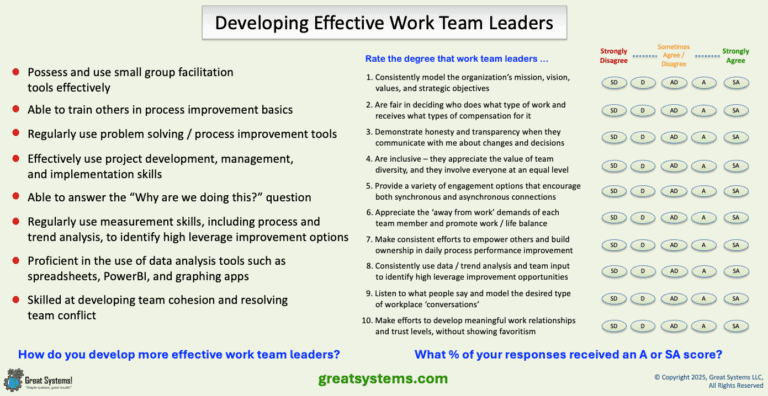Measure and Improve Employee Ownership

How to Measure and Improve Employee Ownership and Engagement
People often ask me how to measure employee ownership in a company. Before we get into the suggestions that I offer, let's first consider the question itself.
Why is it important to have high levels of employee ownership? To some, this might sound like a silly question. Conversely, there are people out there who really don't care if the levels of employee ownership in their company are high or not.
Why do I believe that high levels of employee ownership and engagement are important?
Why is it important to have high levels of employee ownership? To some, this might sound like a silly question. Conversely, there are people out there who really don't care if the levels of employee ownership in their company are high or not.
Why do I believe that high levels of employee ownership and engagement are important?
The Need for High Levels of Employee Ownership and Engagement
To begin with, I believe that we measure and focus what we consider to be important. Does your company measure ownership to some degree? Are strategies in place to improve key ownership metrics over time?
If not, I would question the degree to which employee ownership is important. Over the past twenty-plus years, I have served as an Examiner for the national Malcolm Baldrige Quality Award and also assisted multiple state award programs. I have read many applications over that time.
Through this process, I now see employee ownership and engagement as synonymous. Both are also much more than mere satisfaction.
Secondly, I continue to observe how people are treated in those companies I cross paths with over time. With some I encounter, I would have a hard time taking much ownership in those organizations.
If we allow systems to exist that hinder, or actually decrease, ownership levels as each day goes by, we probably don't care that much about ownership levels.
If not, I would question the degree to which employee ownership is important. Over the past twenty-plus years, I have served as an Examiner for the national Malcolm Baldrige Quality Award and also assisted multiple state award programs. I have read many applications over that time.
Through this process, I now see employee ownership and engagement as synonymous. Both are also much more than mere satisfaction.
Secondly, I continue to observe how people are treated in those companies I cross paths with over time. With some I encounter, I would have a hard time taking much ownership in those organizations.
If we allow systems to exist that hinder, or actually decrease, ownership levels as each day goes by, we probably don't care that much about ownership levels.
After over thirty years of watching the workplace improvement fad pendulum swing away from practices that promote high levels of employee involvement, empowerment, or whatever you want to call treating all your employees like valued individuals, I think we are seeing it swing back towards those necessary practices.
WATCH over 50 kaizen and workplace health improvement videos on my Great Systems YouTube channel.
WATCH over 50 kaizen and workplace health improvement videos on my Great Systems YouTube channel.
What is Work Team or Workforce Ownership and Engagement?
I base my definition of team engagement on my personal experience with teams and on the criteria of the Malcolm Baldrige National Performance Excellence Award. The Baldrige criteria define workforce engagement as 'the extent to which workforce commitment, both emotional and intellectual, exists relative to accomplishing the work, mission, and vision of the organization.'
Work team engagement is a heightened level of ownership, where each employee wants to do whatever they can for the benefit of their internal and external customers, and for the success of the organization as a whole.'
For people to be engaged, the time and mechanisms for involvement must exist. They must believe that their personal contributions matter. Also, they need to be keenly aware of the connection that exists between their daily personal actions and decisions, and the success of the organization.
Engagement implies the existence of strong, meaningful relationships.
To sustain organizational success, all staff must create effective relationships between customers and team members. Think of your teams like a set of gears. How well is each gear tooth (each person), as well as each gear itself (each work team), properly and consistently engaged? If the teeth fail to mesh, a degree of mechanical efficiency is lost. How do you effectively engage your staff and work teams?
Ownership is a result of high staff engagement.
Work team engagement is a heightened level of ownership, where each employee wants to do whatever they can for the benefit of their internal and external customers, and for the success of the organization as a whole.'
For people to be engaged, the time and mechanisms for involvement must exist. They must believe that their personal contributions matter. Also, they need to be keenly aware of the connection that exists between their daily personal actions and decisions, and the success of the organization.
Engagement implies the existence of strong, meaningful relationships.
To sustain organizational success, all staff must create effective relationships between customers and team members. Think of your teams like a set of gears. How well is each gear tooth (each person), as well as each gear itself (each work team), properly and consistently engaged? If the teeth fail to mesh, a degree of mechanical efficiency is lost. How do you effectively engage your staff and work teams?
Ownership is a result of high staff engagement.
The Link Between Ownership, Engagement, and Great Service / Quality Outcomes
Still, the question begs for an answer. Why do we need high levels of employee engagement and ownership?
First of all, is your goal to make a high-quality product or provide a high quality service, but you cannot control the quality of those product or service attributes totally by machines? If so, ownership levels directly affect the quality of your product or service.
If you expect people to move at a fast pace, control quality and costs, and keep customer loyalty high, then work team ownership levels affect work output. Do you count on your people to let you know when problems exist or improvements are needed?
If this is the case, please recognize that their desire to tell you what you need to know is directly proportional to the level of ownership in the company that they feel.
First of all, is your goal to make a high-quality product or provide a high quality service, but you cannot control the quality of those product or service attributes totally by machines? If so, ownership levels directly affect the quality of your product or service.
If you expect people to move at a fast pace, control quality and costs, and keep customer loyalty high, then work team ownership levels affect work output. Do you count on your people to let you know when problems exist or improvements are needed?
If this is the case, please recognize that their desire to tell you what you need to know is directly proportional to the level of ownership in the company that they feel.
How Can You Measure the Current Level of Employee Ownership and Engagement?
There are three primary ways to measure engagement levels. These methods are employee surveys, personal time investment analysis, and information access analysis. The survey measurement approach can be as simple as asking a question on the annual employee opinion survey.
High performance organizations, at minimum, ask multiple questions of an engagement nature. They want to gauge the effectiveness of each of the approaches they use to engage the workforce. Organizations that give each employee an e-mail address and some form of intranet access discover that such connectivity allows for more frequent, and specialized, assessment as well.
Perform a fact-based analysis of how your people spend their 2,000 hours a year. This is an effective means to measure engagement levels. For example, what percentage of your people spend time on training each year?
What percentage of each person's work time is spent attending monthly performance updates or annual planning sessions? How many hours a year does the average employee spend with at least one external customer?
Also, you can use percentages to measure engagement. What percent of people in your workforce can access performance information or receive monthly performance updates? What percent participates in some type of regular team meeting?
Use of a team infrastructure blueprint gives you a quick look at your work team engagement levels.
High performance organizations, at minimum, ask multiple questions of an engagement nature. They want to gauge the effectiveness of each of the approaches they use to engage the workforce. Organizations that give each employee an e-mail address and some form of intranet access discover that such connectivity allows for more frequent, and specialized, assessment as well.
Perform a fact-based analysis of how your people spend their 2,000 hours a year. This is an effective means to measure engagement levels. For example, what percentage of your people spend time on training each year?
What percentage of each person's work time is spent attending monthly performance updates or annual planning sessions? How many hours a year does the average employee spend with at least one external customer?
Also, you can use percentages to measure engagement. What percent of people in your workforce can access performance information or receive monthly performance updates? What percent participates in some type of regular team meeting?
Use of a team infrastructure blueprint gives you a quick look at your work team engagement levels.
How Can We Measure the Feelings of Employee Ownership and Engagement?
Yes, we are talking about feelings. Ownership is a feeling. It is a state of mind or an attitude. This makes it tougher to measure. I believe that all companies rely on ownership to some degree to make money and keep the customer happy, whether they recognize that fact or not. How our people feel does affect the quality of our products and services.
Feelings of ownership also affect the pace of their work, the degree that they work safely and follow the rules, and their willingness to let us know when improvements are needed. How do you measure ownership in your company? Do you think you might benefit from improving your ownership measurement practices?
Here are some possible approaches that I have used, and seen others use, to measure employee ownership levels:
Feelings of ownership also affect the pace of their work, the degree that they work safely and follow the rules, and their willingness to let us know when improvements are needed. How do you measure ownership in your company? Do you think you might benefit from improving your ownership measurement practices?
Here are some possible approaches that I have used, and seen others use, to measure employee ownership levels:
Measures #1 and #2: Internal Customer Survey Results
Measure #1: Internal Customer Survey 'Ownership' STATEMENTS
The most tangible measure of ownership that I have seen used involves the inclusion of an 'ownership' statement on the 'annual' internal customer survey. Top box response rate trends for that statement are analyzed over time, across all internal customer segments.
Example statements include "I take ownership in the success of my company" or "I feel a strong sense of ownership in the products we make."
Unfortunately, not all companies consider their employees to be internal customers. Too many think internal surveys are either a waste of time or something that a company does only every other year or so.
Ownership levels typically don't improve over time without systemic influences of some type. Example system influencers include compensation plan changes, recognition system changes, leadership development, and personal development opportunity enhancements.
#2: Internal Customer Survey Response RATES
The survey response rate itself is an indicator of ownership. This is especially true if you give this type of survey more than once a year.
Yes, there are companies that measure internal customer (employee) attitudes MORE than once a year. In fact, as intranet and social media use grows in companies, it is now more cost effective to do this.
Your survey response rate - the number of completed surveys you get back versus the number distributed - is key. The response rate is a direct reflection of your peoples' belief that the survey will make a difference. It also reflects their desire to make the company more effective.
The design of an internal survey, and the survey administration process itself, also affect response rates. Improve your survey process each time you use it if you want to increase your response rate over time.
Ownership levels, however, do significantly affect this rate. Low survey response rates reflect low ownership levels.
The most tangible measure of ownership that I have seen used involves the inclusion of an 'ownership' statement on the 'annual' internal customer survey. Top box response rate trends for that statement are analyzed over time, across all internal customer segments.
Example statements include "I take ownership in the success of my company" or "I feel a strong sense of ownership in the products we make."
Unfortunately, not all companies consider their employees to be internal customers. Too many think internal surveys are either a waste of time or something that a company does only every other year or so.
Ownership levels typically don't improve over time without systemic influences of some type. Example system influencers include compensation plan changes, recognition system changes, leadership development, and personal development opportunity enhancements.
#2: Internal Customer Survey Response RATES
The survey response rate itself is an indicator of ownership. This is especially true if you give this type of survey more than once a year.
Yes, there are companies that measure internal customer (employee) attitudes MORE than once a year. In fact, as intranet and social media use grows in companies, it is now more cost effective to do this.
Your survey response rate - the number of completed surveys you get back versus the number distributed - is key. The response rate is a direct reflection of your peoples' belief that the survey will make a difference. It also reflects their desire to make the company more effective.
The design of an internal survey, and the survey administration process itself, also affect response rates. Improve your survey process each time you use it if you want to increase your response rate over time.
Ownership levels, however, do significantly affect this rate. Low survey response rates reflect low ownership levels.

LISTEN NOW to my "How to Increase Work Team Engagement" Real Life Work podcast
Measures #3 and #4: Workforce MORALE and INVOLVEMENT
#3: Morale Measures Reflect Ownership Levels
Morale measures also reflect work team ownership levels. Such measures include your absenteeism rate, retention or turnover rate, internal complaint or grievance frequency, and percent attendance at company functions outside of work.
Many companies track some of these measures, but few trend them over time. Even fewer actually consider them to be key performance indicators of ownership.
Do you trend these values over time and review them monthly at your performance review meetings? Are employee ownership measures part of your key performance indicators? Do you have strategies built into your annual or multi-year improvement plans to improve future employee ownership rates?
#4: Work Team Involvement and Idea Submittal Rates
To measure true work team engagement, first look at the degree of connection between each staff member. For example, look at the percentage of your workforce that you involve in key decisions, plan development, and problem solving. How many staff participate in personal development events, customer contacts, and team-based work?
The 'percent involvement' metric provides one way to gauge staff engagement levels. Percentage comparisons help highlight possible engagement gaps.
If you have cross-functional improvement teams that are voluntary in nature, the percentage of employees that participate on these teams is a good indicator of ownership as well. Similarly, if you provide a way for people to contribute to your key improvement project lists, the rate at which they provide such projects is a good ownership indicator.
The degree of work team effectiveness they experience and your ability to actually use, or at least respond to, their suggestions also affects these types of measures. In general, they are good indicators of your peoples' desire to make 'their' company better. To what degree do your people want to help improve the company? How do you know?
Morale measures also reflect work team ownership levels. Such measures include your absenteeism rate, retention or turnover rate, internal complaint or grievance frequency, and percent attendance at company functions outside of work.
Many companies track some of these measures, but few trend them over time. Even fewer actually consider them to be key performance indicators of ownership.
Do you trend these values over time and review them monthly at your performance review meetings? Are employee ownership measures part of your key performance indicators? Do you have strategies built into your annual or multi-year improvement plans to improve future employee ownership rates?
#4: Work Team Involvement and Idea Submittal Rates
To measure true work team engagement, first look at the degree of connection between each staff member. For example, look at the percentage of your workforce that you involve in key decisions, plan development, and problem solving. How many staff participate in personal development events, customer contacts, and team-based work?
The 'percent involvement' metric provides one way to gauge staff engagement levels. Percentage comparisons help highlight possible engagement gaps.
If you have cross-functional improvement teams that are voluntary in nature, the percentage of employees that participate on these teams is a good indicator of ownership as well. Similarly, if you provide a way for people to contribute to your key improvement project lists, the rate at which they provide such projects is a good ownership indicator.
The degree of work team effectiveness they experience and your ability to actually use, or at least respond to, their suggestions also affects these types of measures. In general, they are good indicators of your peoples' desire to make 'their' company better. To what degree do your people want to help improve the company? How do you know?
#5: Other 'Softer' Measures of Employee Ownership
Other more intangible indicators of ownership include general facility cleanliness, how people treat each other each day, and how open people are to sharing performance feedback.
Sometimes, it is tough to come up with a number for these types of indicators. One way to easily gauge progress in these areas is to regularly walk through the facility or sit in the breakroom. High value also comes from simply listening to people.
Another intangible ownership indicator is the degree that people support a formal improvement initiative, such as 5S, lean six sigma, or process improvement teams. What percent of your workforce participates in such formal efforts?
How much ownership do your supervisors and managers show through their personal process improvement efforts? How do their personal ownership levels and feelings affect the ownership levels of their people?
Sometimes, it is tough to come up with a number for these types of indicators. One way to easily gauge progress in these areas is to regularly walk through the facility or sit in the breakroom. High value also comes from simply listening to people.
Another intangible ownership indicator is the degree that people support a formal improvement initiative, such as 5S, lean six sigma, or process improvement teams. What percent of your workforce participates in such formal efforts?
How much ownership do your supervisors and managers show through their personal process improvement efforts? How do their personal ownership levels and feelings affect the ownership levels of their people?
How to Improve Employee Ownership and Engagement
When I first entered the world of work more than 40 years ago, employee involvement was the rage. Now, organizations realize that both effective individual and work team engagement are critical to achieve true, sustainable operational excellence levels.
Unfortunately, many don't know how to increase work team engagement. On this page, I share some engagement ideas that work for me.
First, people are the foundation of organizational success. ALSO, engagement reflects a degree of connection that goes beyond 'mere' involvement.
However, true, meaningful engagement is not easy to come by. This is especially true if your prevailing work culture encourages employee disengagement. The phrase 'I am only going to do what they tell me to, and nothing more' comes to mind.
For starters, trend key measures over time for all employee group segments to gain the best feedback of your employee ownership building success. Example measures are provided in the infographic.
How important is it to measure and improve employee ownership levels over time?
Unfortunately, many don't know how to increase work team engagement. On this page, I share some engagement ideas that work for me.
First, people are the foundation of organizational success. ALSO, engagement reflects a degree of connection that goes beyond 'mere' involvement.
However, true, meaningful engagement is not easy to come by. This is especially true if your prevailing work culture encourages employee disengagement. The phrase 'I am only going to do what they tell me to, and nothing more' comes to mind.
For starters, trend key measures over time for all employee group segments to gain the best feedback of your employee ownership building success. Example measures are provided in the infographic.
How important is it to measure and improve employee ownership levels over time?
Why Do We Need to Improve Employee Ownership and Engagement?
Unfortunately, most organizations only engage a small percentage of their work team members in activities outside of their daily work area. Do your own self-check. Look at how your people, at all levels, spend their time at work. What different mixes of people could you involve in your 'traditionally' middle and upper management work processes?
I use the gear analogy to help define 'engagement.' This example helps make the need for high engagement percentages obvious. The theory is that there is a direct correlation between engagement levels and organizational success.
As engagement levels rise across a variety of activity types, the number of gear teeth and gears that mesh goes up. In turn, the organizational machine moves to a higher level of performance. Greater engagement and stronger relationships create greater levels of understanding and ownership.
Do your people understand what their customers want, and why they want those things? If so, they are more apt to make decisions and take actions that are consistent with those needs.
What percent of your people have a sound understanding of what the organization wants to accomplish? What percentage can describe how organizational success affects their own personal success and growth?
Highly engaged staff are more likely to consistently behave and act in a manner that supports the mission and vision of the organization. Disengaged people only work to support their own personal needs or to keep their boss happy.
I use the gear analogy to help define 'engagement.' This example helps make the need for high engagement percentages obvious. The theory is that there is a direct correlation between engagement levels and organizational success.
As engagement levels rise across a variety of activity types, the number of gear teeth and gears that mesh goes up. In turn, the organizational machine moves to a higher level of performance. Greater engagement and stronger relationships create greater levels of understanding and ownership.
Do your people understand what their customers want, and why they want those things? If so, they are more apt to make decisions and take actions that are consistent with those needs.
What percent of your people have a sound understanding of what the organization wants to accomplish? What percentage can describe how organizational success affects their own personal success and growth?
Highly engaged staff are more likely to consistently behave and act in a manner that supports the mission and vision of the organization. Disengaged people only work to support their own personal needs or to keep their boss happy.
How Do I Engage More People in the Pursuit of Organizational Goals?
To increase engagement levels, you need to pursue two key engagement ideas. First, you must change job designs and job descriptions. In other words, people need to spend their time at work a little bit differently each day. Leaders provide different direction to work.
How much time is required to attend a monthly performance review meeting or to participate in an annual improvement or planning day? It does not take that big of a dent out of the 2,000 hours a year the average person spends at work to attend 2-3 hours of training or group problem solving a month.
The use of these example engagement ideas alone results in only a 3% impact on time. Properly design and facilitate these events, and the benefits you realize from these investments will far outweigh the costs.
The second change to make is perhaps the tougher of the two. Fortunately, the related costs are very low. You must decide how to involve all levels of your workforce in activities that traditionally were reserved for members of management.
How much time is required to attend a monthly performance review meeting or to participate in an annual improvement or planning day? It does not take that big of a dent out of the 2,000 hours a year the average person spends at work to attend 2-3 hours of training or group problem solving a month.
The use of these example engagement ideas alone results in only a 3% impact on time. Properly design and facilitate these events, and the benefits you realize from these investments will far outweigh the costs.
The second change to make is perhaps the tougher of the two. Fortunately, the related costs are very low. You must decide how to involve all levels of your workforce in activities that traditionally were reserved for members of management.
Why Do Leaders Fail to Engage More Staff in Planning and Improvement?
Sadly, in many organizations, even the middle and front-line leaders are not involved in planning and personal development as they should be. At times, upper organizational leadership is afraid to share what is thought to be sensitive information. Often, they don't trust their people.
Unfortunately, without trust, engagement does not occur. At the same time, it is tough to improve trust levels without developing the stronger relationships that are part of true engagement. It is a vicious, systemic cycle. This cycle spins in either the positive (growth) or negative (erosion) direction.
In those cases where trust (solid, positive relationships) do exist, job designs may not provide enough time 'away from the process' for such engagement. For example, low work team skill levels may require a work team leader to spend most of their time with the process work team.
In turn, little work time exists for project meetings or personal development activities.
Unfortunately, without trust, engagement does not occur. At the same time, it is tough to improve trust levels without developing the stronger relationships that are part of true engagement. It is a vicious, systemic cycle. This cycle spins in either the positive (growth) or negative (erosion) direction.
In those cases where trust (solid, positive relationships) do exist, job designs may not provide enough time 'away from the process' for such engagement. For example, low work team skill levels may require a work team leader to spend most of their time with the process work team.
In turn, little work time exists for project meetings or personal development activities.
What is the Most Critical Factor for Improving Staff Engagement and Ownership?
Upper managers must make key information access and job design change decisions that affect engagement levels. However, the most critical factor that helps or hinders team engagement lies in the abilities of EACH of your process owners to promote and increase such levels.
Work team leader performance in this area is most critical. A high majority of your people get daily information about what the organization wants to accomplish from these people. However, both intentional and unintentional messages can be sent.
Work team leaders are key if you want to develop stronger internal customer relationships. Plus, these people decide how much effort is made to 'free people up' for training and team participation. Finally, work team leaders are the people we expect to effectively lead most of the work events the bulk of the workforce attends.
Do you want to develop effective engagement skills in each of your leaders? If so, you must teach them to use effective facilitation skills. Also, effective work team leaders regularly engage their people in a formal manner. Plus, these expectations are part of their job description.
As time passes, expect your leaders to increase their skill proficiency in these areas. Too many organizations fail to ensure, let alone improve, the skills of their leaders in these key areas. For true work team engagement to both exist and improve over time, all work team leaders must personally, and effectively, engage their people.
Work team leader performance in this area is most critical. A high majority of your people get daily information about what the organization wants to accomplish from these people. However, both intentional and unintentional messages can be sent.
Work team leaders are key if you want to develop stronger internal customer relationships. Plus, these people decide how much effort is made to 'free people up' for training and team participation. Finally, work team leaders are the people we expect to effectively lead most of the work events the bulk of the workforce attends.
Do you want to develop effective engagement skills in each of your leaders? If so, you must teach them to use effective facilitation skills. Also, effective work team leaders regularly engage their people in a formal manner. Plus, these expectations are part of their job description.
As time passes, expect your leaders to increase their skill proficiency in these areas. Too many organizations fail to ensure, let alone improve, the skills of their leaders in these key areas. For true work team engagement to both exist and improve over time, all work team leaders must personally, and effectively, engage their people.
How Can Great Systems Help You Improve Engagement and Ownership Levels?
Great Systems helps you assess your current team engagement levels and develop a plan to increase those levels over time. Plus, I help you design and install more effective work systems to help increase engagement levels. Common processes include workplace health surveys, recognition programs, and team infrastructure design.
Regularly, I work with others to help them learn more about, and practice, team facilitation skills. People need such skills to effectively lead and facilitate team meetings. Also, skill use helps build stronger relationships between internal and external customers. Do your leaders know how to increase work team engagement levels?
High levels of team engagement are requisite to sustain best-in-class performance levels. This fact only becomes more important as our workforces become more diverse, and as customer expectations continue to shift and grow.
I invite you to learn to do what the high performers already know is effective. Change your work systems to increase work team engagement. If you do so, gains in performance will follow.
Regularly, I work with others to help them learn more about, and practice, team facilitation skills. People need such skills to effectively lead and facilitate team meetings. Also, skill use helps build stronger relationships between internal and external customers. Do your leaders know how to increase work team engagement levels?
High levels of team engagement are requisite to sustain best-in-class performance levels. This fact only becomes more important as our workforces become more diverse, and as customer expectations continue to shift and grow.
I invite you to learn to do what the high performers already know is effective. Change your work systems to increase work team engagement. If you do so, gains in performance will follow.






